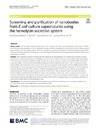Please use this identifier to cite or link to this item:
https://accedacris.ulpgc.es/jspui/handle/10553/69843
| Title: | Screening and purification of nanobodies from E. coli culture supernatants using the hemolysin secretion system | Authors: | Ruano-Gallego, David Fraile, Sofía Gutiérrez Cabrera, Carlos Javier Fernández, Luis Ángel |
UNESCO Clasification: | 310907 Patología 310801 Bacterias |
Keywords: | E. Coli/Hemolysin Nanobodies Protein Secretion Single-Domain Antibodies |
Issue Date: | 2019 | Journal: | Microbial Cell Factories | Abstract: | The hemolysin (Hly) secretion system of E. coli allows the one-step translocation of hemolysin A (HlyA) from the bacterial cytoplasm to the extracellular medium, without a periplasmic intermediate. In this work, we investigate whether the Hly secretion system of E. coli is competent to secrete a repertoire of functional single-domain VHH antibodies (nanobodies, Nbs), facilitating direct screening of VHH libraries and the purification of selected Nb from the extracellular medium. Results: We employed a phagemid library of VHHs obtained by immunization of a dromedary with three protein antigens from enterohemorrhagic E. coli (EHEC), namely, the extracellular secreted protein A (EspA), the extracellular C-terminal region of Intimin (Int280), and the translocated intimin receptor middle domain (TirM). VHH clones binding each antigen were enriched and amplified by biopanning, and subsequently fused to the C-terminal secretion signal of HlyA to be expressed and secreted in a E. coli strain carrying the Hly export machinery (HlyB, HlyD and TolC). Individual E. coli clones were grown and induced in 96-well microtiter plates, and the supernatants of the producing cultures directly used in ELISA for detection of Nbs binding EspA, Int280 and TirM. A set of Nb sequences specifically binding each of these antigens were identified, indicating that the Hly system is able to secrete a diversity of functional Nbs. We performed thiol alkylation assays demonstrating that Nbs are correctly oxidized upon secretion, forming disulphide bonds between cysteine pairs despite the absence of a periplasmic intermediate. In addition, we show that the secreted Nb-HlyA fusions can be directly purified from the supernatant of E. coli cultures, avoiding cell lysis and in a single affinity chromatography step. Conclusions: Our data demonstrate the Hly secretion system of E. coli can be used as an expression platform for screening and purification of Nb binders from VHH repertories.[Figure not available: see fulltext.] | URI: | https://accedacris.ulpgc.es/handle/10553/69843 | DOI: | 10.1186/s12934-019-1094-0 | Source: | Microbial Cell Factories, v. 18 (1) |
| Appears in Collections: | Artículos |
SCOPUSTM
Citations
42
checked on Jun 8, 2025
WEB OF SCIENCETM
Citations
37
checked on Jun 8, 2025
Page view(s)
175
checked on May 31, 2025
Download(s)
182
checked on May 31, 2025
Google ScholarTM
Check
Altmetric
Share
Export metadata
Items in accedaCRIS are protected by copyright, with all rights reserved, unless otherwise indicated.
